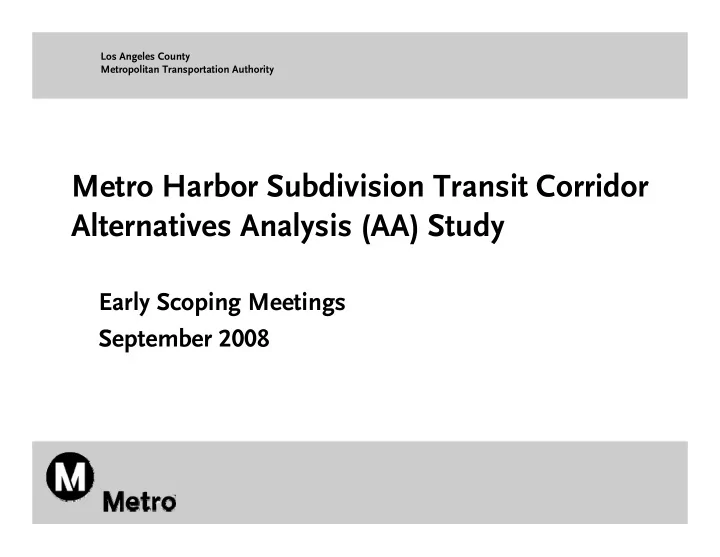

Los Angeles County Metropolitan Transportation Authority Metro Harbor Subdivision Transit Corridor Alternatives Analysis (AA) Study Early Scoping Meetings September 2008
Agenda • Meeting Objectives • Project Introduction • Purpose & Need • Alternatives • Evaluation Criteria • Public / Stakeholder Outreach • Questions / Comments
Meeting Objectives • Solicit comments from public and stakeholders concerning: – Purpose & Need for the project – Alternatives to be considered – Potential environmental issues along corridor – Evaluation Criteria to be used for AA Study
Alternatives Analysis Process First step in defining a project • Evaluation of a wide range of alternatives • Screening of alternatives against criteria • Selection of most promising alternative(s) to proceed into further environmental review 3
Where We Are In The Process Initial Alternatives Identified AA Report Additional Promising Early Initial Conceptual for Screening Conclusion Analysis Alternatives Scoping Screen Alternatives Winter ‘ Winte ‘08 Spring ‘09 Spring ‘09 Fall ‘09 Fall ‘09 Fall ‘08 Fall ‘08 Alt B Alt B B A C Modal Alternatives Alt F D E F Alt M Routing Alt H Alternatives H G I J K L No Build No Build Alt K M N O TSM Alt M P Q TSM No No Build TSM Recommendation Build TSM
Tentative Project Schedule Jun. 08 Sep. 08 Feb. 09 Sep. 09 Oct. 09 Project Kickoff Project Initiation / Alternative Definition Early Scoping Meetings Alternative Screening Public Meetings #2 Conceptual Engineering / Analysis Public Meetings #3 Prepare AA Report Metro Board Action
Project Study Area • Harbor Subdivision purchased by Metro in early 1990’s • Traverses 12 jurisdictions • Extends from south of downtown Los Angeles to north of the Port of Los Angeles • Approx. 26 miles long (approx. 85 sq. miles) • BNSF operates freight service along corridor
Draft Purpose & Need • Improve mobility in southwestern Los Angeles County by introducing high-frequency transit service options • Enhance the regional transit network by interconnecting existing and planned rapid transit lines • Provide an alternative mode of transportation for commuters who currently use the congested I- 405 and I-110 corridors • Improve transit accessibility for residents of the communities along the corridor • Encourage a mode shift to transit, reducing air pollution and greenhouse gas emissions
Modal Alternatives to be Studied • No Build • Transportation Systems Management (TSM) • Bus Rapid Transit (BRT) • Rail Technologies: – Light Rail Transit (LRT) – Self-propelled Railcars – Commuter Rail (Metrolink) • Other
Routing Alternatives to be Studied • Northern Terminus Options (Los Angeles Union Station, 7 th / Metro, etc) • Southern Terminus Options (Metro Blue Line, Harbor Transitway, Downtown Torrance, San Pedro, etc) • Phased Segment Options
Proposed Evaluation Criteria • Costs (Capital, • Environmental Operating & Benefits/Impacts Maintenance) • Environmental • Ridership & User Sustainability Benefits • Cost-Effectiveness • Equity • Travel Time, Reliability • Financial Feasibility & Connectivity • Safety & Security • Transit Supportive Land Use • Compatibility with Other • Transportation System Modes on the Corridor Benefits/Impacts
Public Outreach Meetings • Early Scoping Meetings – September 23, 2008 – Torrance (6:30-8:30 pm) – September 24, 2008 – Wilmington (6:30-8:30 pm) – September 25, 2008 – Huntington Park (6-8 pm) – September 30, 2008 – El Segundo (6-8 pm) • Public Meetings – Round 2 – Late February 2009 • Public Meetings – Round 3 – Mid September 2009
Opportunities to Provide Input Please submit comments by October 22, 2008 • Complete Comment Card • By Mail: Kathleen McCune, Project Manager One Gateway Plaza – MS 99-22-3 Los Angeles, CA 90012 • By Phone: (213) 922-4004 • Email: harborsubdivision@metro.net • On the web at: www.metro.net/harborsubdivision (Click on “Contact Us”)
Discussion • Comments & Questions
Recommend
More recommend